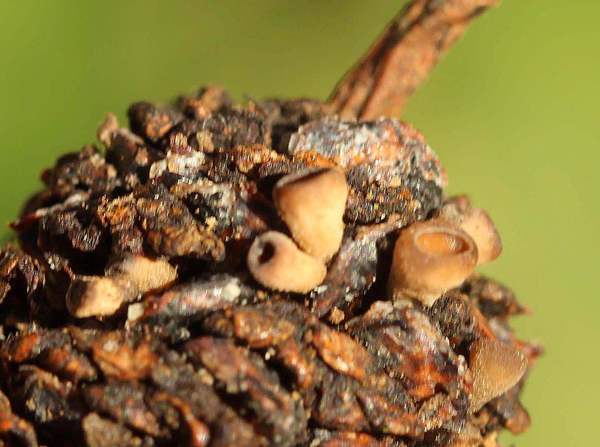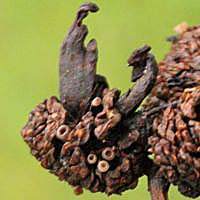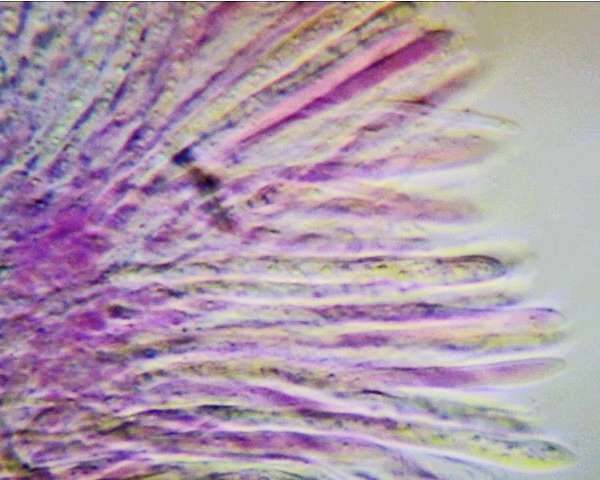Ciboria viridifusca (Fuckel) Höhn.
Phylum: Ascomycota - Class: Leotiomycetes - Order: Helotiales - Family: Sclerotiniaceae
Distribution - Taxonomic History - Etymology - Identification - Reference Sources

Between late autumn and late spring, many small ascomycete fungi fruit on rotting vegetable matter. Fallen catkins and seed cones of various hardwood trees, particularly Poplars, Alders and Willows are host substrates for several similar species.
Ciboria viridiformis fruits on the rotting female cone-like flowers of Black Alder Alnus glutinosa (a common riverside tree) and other members of the Alnus genus. The tiny apothecia are easily overlooked, and so this seldom recorded ascomycete may not be as scarce as formal records suggest.
Distribution
In Britain and Ireland Ciboria viridiformis is an uncommon to rare find with what seems to be a rather patchy distribution. This little ascomycete has a geographical distribution that includes most of Europe and parts of North America.
Taxonomic history
When German mycologist Karl Wilhelm Gottlieb Leopold Fuckel (1821 - 1876) described this little ascomycete fungus, in 1870, he gave it the scientific name Peziza viridifusca. Its currently accepted name Ciboria viridifusca comes from a 1926 publication by Austrian mycologist Franz Xaver Rudolf von Höhnel (1852 - 1920).
Synonyms of Ciboria viridifusca include Peziza veridifusca Fuckel, Phialea viridifusca (Fuckel) Sacc., Ombrophila viridifusca (Fuckel) Rehm., Ciboria amenticola (P. Karst.) Boud., and Hymenoscyphus viridifuscus (Fuckel) Kuntze.
Etymology
Ciboria, the genus name, comes from the medieval Latin noun Ciborium, a drinking vessel - a reference to the chalice-like shape of the young apothecia. The specific epithet viridifusca comes from the Latin verb vireo-, meaning to sprout or to be verdant (and hence often implying the colour green), and -fusca meaning dark or dusky.
Identification guide
 |
FruitbodyInitially cup shaped, becoming slightly domed and at maturity sometimes splitting at the margin, individual fruitbodies (apothecia) are usually 1 to 4mm in diameter. The fertile upper surface (the hymenophore) is smooth and various shades of reddish brown. The infertile external surface is usually a little paler and pruinose at least when young. Dark brown at the top, the stem, typically 2 to 3 cm long, tapers and darkens becoming almost black towards the base. Coarse raised ribs start at the apex of the stem and extend to about a third of the way to the margin. |
AsciEight-spored; typically 4.5 x 65µm. ParaphysesNarrow, filiform or slightly clavate; extending just beyond the asci. |
|
SporesEllipsoidal, smooth, 6-10 x 2.5-4µm, hyaline, with two darkish oil drops when mature. Spore printWhite. |
|
Odour/taste |
Not distinctive. |
Habitat & Ecological role |
Saprobic, on wet rotting female cone-like flowers of Alders. |
Season |
Winter and early spring, mainly November to March in Britain and Ireland). |
Similar species |
Ciboria caucus (Rebent.) Fuckel is a typically larger long-stemmed cup fungus that grows mainly on the rotting male catkins of Alders and Poplars; it is the type species of the Ciboria genus. Species in this genus are best separated by microscopic characters such as ascus dimensions and spore size. |
Reference Sources
Fascinated by Fungi, 2nd Edition, Pat O'Reilly 2016, reprinted by Coch-y-bonddu Books in 2022.
Dennis, R.W.G. (1981). British Ascomycetes; Lubrecht & Cramer; ISBN: 3768205525.
Breitenbach, J. & Kränzlin, F. (1984). Fungi of Switzerland. Volume 1: Ascomycetes. Verlag Mykologia: Luzern, Switzerland.
Medardi, G. (2006). Ascomiceti d'Italia. Centro Studi Micologici: Trento.
Dictionary of the Fungi; Paul M. Kirk, Paul F. Cannon, David W. Minter and J. A. Stalpers; CABI, 2008
Taxonomic history and synonym information on these pages is drawn from many sources but in particular from the British Mycological Society's GB Checklist of Fungi.
Acknowledgements
This page includes pictures kindly contributed by Iris Millar.
Fascinated by Fungi. Back by popular demand, Pat O'Reilly's best-selling 450-page hardback book is available now. The latest second edition was republished with a sparkling new cover design in September 2022 by Coch-y-Bonddu Books. Full details and copies are available from the publisher's online bookshop...


